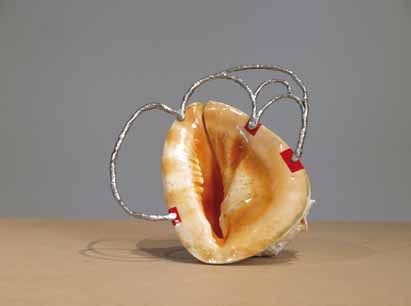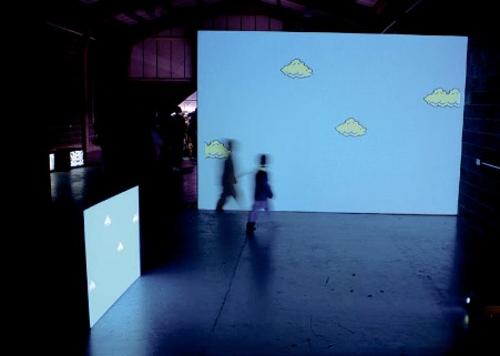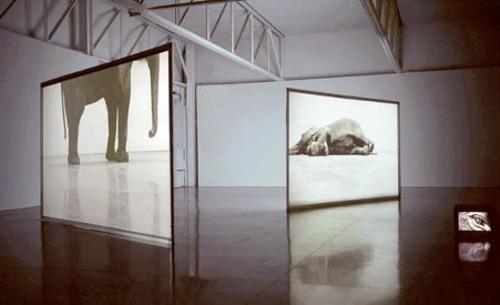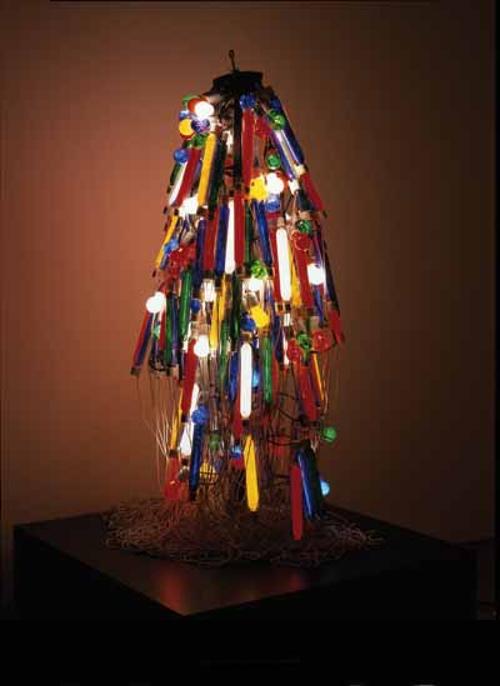
Is it possible that in the deep morass of contemporary art that streams across our eyes via the net, galleries, biennales and magazines that there are new paradigms forming? Though it is a long time since isms in art followed each other like toy trains on a toy track it is good sometimes to stop and think about commonalities. In three recent exhibitions in Adelaide local artists engaged in what I like to think of as a new kind of arte povera. Such work responds to the environmental crisis in which we find ourselves by not buying scads of new materials but by recycling old stuff, sometimes garbage, and doing ingenious things with it. It is a form of art that makes poverty a virtue or at least a principled stand. It is also about resisting consumerism, taking a stand, activism and culture jamming.
First there is Laura Wills' parkside nomadic group's shelter made from flattened cardboard boxes joined together with sticks and string. Wills made it with collaborator Will Cheesman and calls it a wurly. It has clear echoes of shelters made by Aboriginal people and contains a sleeping bag, odds and ends, and a box of wood for the fire that we can easily envisage being alongside it. On the inside surface of the shelter are drawings of almost everything you can imagine and this takes the viewer back to Lascaux, to Kakadu, or perhaps to their bedroom or school desk as a child where they decorated their environment with words, aeroplanes and animals. Wills also shows bags made from old jumpers that have been unraveled and a series of figurative crayon drawings on maps of people traveling. The figures are sourced from National Geographic magazines, they span races and nationalities, and awaken thoughts of global migrations of people, of a world in which all people are nomads, tracking across the earth, escaping disaster, seeking home, and perhaps finding it in movement.
James Dodd also writes on the walls but it is a very verbal graffiti from various subcultures that he imitates. Yet it is very literate and includes wordplay and humor like much graffiti. The making of stencils from beer cartons is also demonstrated and Dodd shows light shades made from the cartons. He has also made a construction using cardboard and cheap wood and here I was reminded of Colin Duncan's cubby made from cardboard shown at the EAF in 1995 and, as seen more recently at the Ian Potter Museum in Melbourne in the exhibition A room inside, curated by Joanne Bosse, Ronnie van Hout's two-thirds size reproduction of his childhood bedroom covered in a kind of resinous brown clag and something like Wills' shelter drawings on the inside walls.
In Dodd's accompanying video we see some indication of an informal art network where people are asked by email or sms to come and party and paint or create on condemned or abandoned premises. The message gives an address and says: 'Feel free to bring music or set up electricity in fact', it says, 'just feel free.' The potential freedom of poverty, the idea of voluntary poverty, voluntary simplicity, and resisting consumerism is also present in Bridget Currie's work New Vow of Poverty in which she uses five cent pieces with holes drilled in them as decorations. They are attached to old clothes which lie on the floor where they have been left by volunteer performers. Louise Haselton moves to the flaky end of going without by quite expensively making quasi-New Age/modernist shrines and talismans using shells and crystals. The cover of the catalogue for Years without Magic shows an older work by Haselton of holes in the shapes of hands squeezed into candles. Imitating some kind of prayer the candles hold up absence like a flame. In Haselton's work called Whatever this is that we are in, we are in it together, five spider shells have their points pierced at five points, and, linked to each other with chains, are spread across a yellow wall suggesting a non-religious but still religious solidarity. This arte povera may not be new but it may possess a new spirit.












